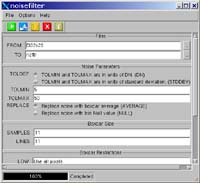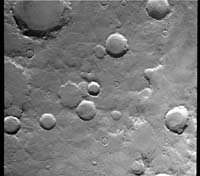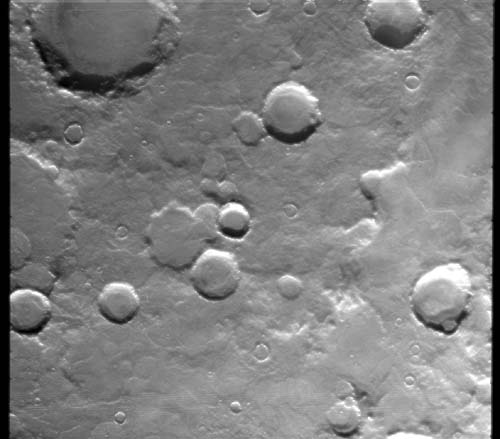If DN is chosen TOLMIN and TOLMAX are in dn units. If STDDEV is
chosen, TOLMIN and TOLMAX are number of standard deviations.
|
Type
| string |
|
Default
| DN |
|
Option List:
|
|
Option |
Brief |
Description |
| DN |
TOLMIN and TOLMAX are in units of DN.
|
If the difference between the input pixel and the boxcar average
is greater then the tolerances given in TOLMIN or TOLMAX (values
of DN), the pixel is considered to be noise and will be replaced.
See TOLMIN and TOLMAX for more details.
Exclusions
|
| STDDEV |
TOLMIN and TOLMAX are in units of standard deviation.
|
If the difference between the input pixel and the boxcar average is
greater than the number of standard deviations indicated in TOLMIN
or TOLMAX, the pixel is considered to be noise and will be replaced.
See TOLMIN and TOLMAX for more details.
Inclusions
|
|
Minimum tolerance value used in the STDDEV filter. If the difference
between the original pixel, and the average value of the noise filter is
less than the FLATTOL then the output pixel will remain unchanged
from the input pixel. Without this safeguard, very uniform inage areas
(low standard deviation) will be excessively smoothed, creating areas
of constant DN.
|
Type
| double |
|
Default
| 0.0 |
|
Minimum
| 0.0
(inclusive)
|
If you are attempting to remove black speckle or other dark noise then you should be modifying this
parameter. When a pixel is being checked for noise, a difference between the pixel and boxcar
average is computed. If this difference is negative then TOLMIN will be used to determine if we
have noise, hence dark noise will be removed by modifying TOLMIN.
For the DN option, if the absolute value of the difference (pixel - average) is less than TOLMIN, then
the input pixel is preserved. Otherwise it is considered noisy and will be replaced.
For the STDDEV option, if the absolute value of the difference is less than TOLMIN * standard deviation
of the boxcar then the input pixel is preserved. Otherwise it is considered noisy and will be replaced.
In general, a high tolerance means fewer pixels will be replaced and lower tolerance will cause more
pixels to be replaced. Too small of a tolerance can actually replace real/good data. For the STDDEV option,
you might try TOLMIN=3 as a starting point. For the DN option, try TOLMIN=2.
|
Type
| double |
|
Default
| 20 |
|
Minimum
| 0.0
(exclusive)
|
If you are attempting to remove white speckle or other bright noise then you should be modifying this
parameter. When a pixel is being checked for noise, a difference between the pixel and boxcar
average is computed. If this difference is positive then TOLMAX will be used to determine if we
have noise, hence white noise will be removed by modifying TOLMAX.
For the DN option, if the difference (pixel - average) is less than TOLMAX, then the input pixel is
preserved. Otherwise it is considered noisy and will be replaced.
For the STDDEV option, if the difference is less than TOLMAX * standard deviation of the boxcar then the
input pixel
is preserved. Otherwise it is considered noisy and will be replaced.
In general, a high tolerance means fewer pixels will be replaced and lower tolerance will cause more
pixels to be replaced. Too small of a tolerance can actually replace real/good data. For the STDDEV option,
you might try TOLMAX=3 as a starting point. For the DN option, try TOLMAX=2.
|
Type
| double |
|
Default
| 20 |
|
Minimum
| 0.0
(exclusive)
|
This is the value that is used to replace pixels which are
considered to be noise.
|
Type
| string |
|
Default
|
AVERAGE
|
|
Option List:
|
|
Option |
Brief |
Description |
| AVERAGE | Replace noise with boxcar average |
If the input pixel is considered as noise, it is replaced
with the average value of the boxcar.
|
| NULL | Replace noise with Isis Null value |
If the input pixel is considered noise, it is replaced with
the Isis Null value.
|
|





